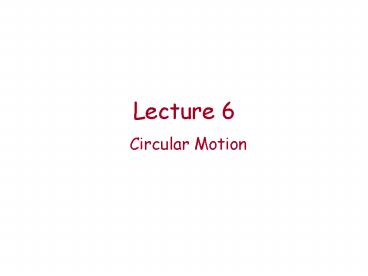Circular Motion PowerPoint PPT Presentation
1 / 26
Title: Circular Motion
1
Lecture 6
- Circular Motion
2
ACT Battleship
A battleship simultaneously fires two shells at
enemy ships. If the shells follow the parabolic
trajectories shown, which ship gets hit first?
v0Ay gt v0By because A goes higher. Thus, tA gt tB
A. A B. B C. Both at the same time
The vertical part of the motion dictates the time
a projectile spends in the air.
3
Example Freds snowball
Fred throws two snowballs with initial speed v0,
at angles ?1 67.5 and ?2 22.5. Find the
ratio of their ranges, R1/R2 and the ratio of
their time in flight t1/t2.
- 3 and 3
- 2.4 and 3
- 3 and 2.4
- 1 and 2.4
- 2.4 and 1
4
Range total ?x
5
Fred throws two snowballs with initial speed v0,
at angles ?1 67.5 and ?2 22.5. Find the
ratio of their ranges, R1/R2 and the ratio of
their time in flight t1/t2.
- 3 and 3
- 2.4 and 3
- 3 and 2.4
- 1 and 2.4
- 2.4 and 1
6
Circular Motion
Circular motion is the motion in a circle with
constant radius.
Relation to Cartesian coordinates x r cos ? y
r sin ?
7
Velocity
Cartesian coordinates
8
EXAMPLE Two balls
Two balls connected by thin rod as shown, at
distances R and 2R from the center, move in
circles.
Same angular speed ? for both (same angle in any
?t)
Different (linear) speeds (ball 2 travels twice
the distance in any ?t)
9
Uniform circular motion (UCM)
? is constant.
10
For any periodic motion
- Period T Time it takes to go back to the same
situation (same position, same velocity). - Frequency f Number of revolutions per unit
time. - Units Hz (turns per second), rpm (rev
per min)
y
t
11
Example Ferris Wheel
A Ferris Wheel of radius 8.0 m rotates at a
constant rate of 1.5 rpm. Find
a. The period
b. The linear speed of a cabin.
12
ACT Ferris wheel
- The ferris wheel in the figure rotates
counterclockwise at a uniform rate. What is the
direction of the average acceleration of a
gondola as it goes from the top to the bottom of
its trajectory?
A. Down B. C. The acceleration is 0 because the
motion is uniform.
13
Radial or centripetal acceleration
During uniform circular motion, speed is
constant, but velocity is not!!! The direction
keeps changing!
14
Radial acceleration
Visually Lets look at the average acceleration.
vf
vi
15
Magnitude of Radial Acceleration
For UCM
xR cos ?t yR sin ?t
16
Acceleration simulator
In the movie The Right Stuff, a seat at the end
of a long arm that rotates very fast is used to
prepare astronauts for high accelerations.
?
R
If R 5 m, what is the speed needed to have a
5g?
17
Does this make sense?
- The rate at which the velocity is shifting
grows.
- The amount of velocity which needs to be
shifted around also grows.
18
- The subtle point To have uniform circular
motion, the acceleration needs to be exactly
v²/R.
19
Non-uniform circular motion
Radial acceleration (towards the center) ?
changes in direction Tangential
acceleration (tangential to trajectory) ? changes
in speed
20
Non-uniform circular motion
That sloppy but visual proof, for the slowing
down case
vf
vi
R
vf ?vi does not point to the center, so a does
not point to the center either!
21
Angular acceleration
If linear speed v is changing, the angular speed
? is also changing Angular acceleration
22
Equations of motion when ? constant
The derivation is formally identical to what we
did in 1D
23
ACT Angular speed
A horizontal rod of length 1 m turns with
constant speed about a vertical axis. The blue
tip of the rod makes one turn each second. Find
the angular speed of the red spot painted in the
middle of the rod.
- p rad/s
- 2p rad/s
- 4p rad/s
24
The linear speed is not
1 m
25
Example Grinding wheel
At t 0, a grinding wheel has an angular
velocity of 24.0 rad/s. It has an constant
angular acceleration of 30.0 rad/s2 until a
circuit breaker trips at t 2.00 s. From then
on, it turns through 432 rad as it coasts to a
stop at constant angular acceleration. What was
its acceleration as it slowed down?
Checks Sign Units
ok
ok
26
Special combinations of velocity and acceleration
- If v 0 and a points down
- object begins moving down
- If v ? 0 and a ? 0 and a perpendicular to v
- speed is constant and motion is a curve. (If the
acceleration is equal to v2/R, the curve is a
circle.) - If v ? 0 and a ? 0 but a not perpendicular to v
- speed is not constant and motion is a curve. (If
the part of the acceleration that is
perpendicular to v is equal to v2/R, the curve is
a circle.)

